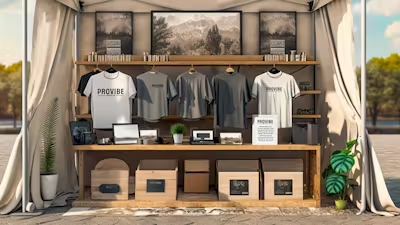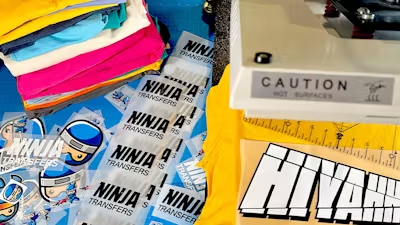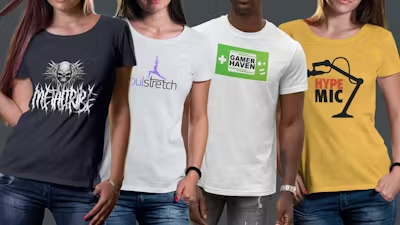Welcome to Chapter 1 of The Ultimate T-Shirt Business Success Guide: "How to Start a T-Shirt Business".
Embark on an exciting journey as we explore the essential steps to kickstart your own t-shirt business from scratch. This chapter provides an overview of different business models, innovative printing methods, finding your niche, building a standout brand, designing irresistible products, setting up effective sales channels, and crafting impactful marketing strategies.
Each section offers concise explanations with real-world examples and links to later chapters for an in-depth dive into each topic. By the end of this chapter, you'll be equipped with the knowledge to launch your t-shirt business and pave your way to success. Ready to turn your dream into reality? Let’s get started!
Table Of Contents
-
What’s so great about the t-shirt business?
-
T-shirt business models: Understanding the landscape
-
T-shirt print methods: What you need to know
-
Finding the perfect niche for your brand
-
Creating your t-shirt brand identity
-
Designing t-shirts that sell
-
Choosing the right products
-
Storefronts and sales channels
-
Effective marketing in the digital era
-
Launching your t-shirt business: The roadmap to success

What's so great about the t-shirt business?
The global t-shirt market is booming, reaching $7.21 billion in 2023, with an expected growth to over $10 billion by 2027 at a compound annual growth rate (CAGR) of 8.7%. Several key factors contribute to the soaring demand and opportunities:
- E-commerce and mobile commerce have opened up the t-shirt market worldwide. Shoppers can now easily discover and purchase shirts from anywhere through online stores and marketplaces.
- Print-on-demand technology allows for limitless creativity and customization without big upfront investments. Shirts can be printed on-demand when ordered.
- Dropshipping streamlines logistics by shipping shirts directly from the printer to customers. This removes inventory responsibilities.
- Social media marketing provides direct access to target audiences who actively share and promote brands they love.
- Accessible design tools like Canva and Adobe Express empower anyone to create shirt designs, and new AI tools generate images in seconds.
- Affordable and simple website builder platforms make setting up DIY e-commerce shops easy.

T-shirts present a great business opportunity because of the huge market demand and relatively low barriers to entry. Advanced print methods like direct-to-film transfers allow high-quality customization without massive startup costs or equipment.
There's never been a better time to join the flourishing custom apparel industry. With the right plan and execution, you can turn your creative ideas into a thriving t-shirt business.

T-shirt business models: Understanding the landscape
One of the first key decisions is choosing your business model. This crucial choice will impact everything from startup costs and inventory to profit margins and scalability. There are a few main options, each with its own pros and cons.
Traditional bulk printing requires working with a screen printing partner to produce large batches of pre-printed shirts upfront. This demands more initial capital investment in inventory, but allows higher per-unit profit margins when selling the finished goods, with the tradeoff of managing warehouse storage and excess stock risks.
Print-on-demand (POD) integrates with e-commerce platforms to print shirts individually when customer orders come in, eliminating upfront inventory costs. While enabling unlimited creativity and zero overstock risk, POD has limited quality control, product options, and the profit margins are lower.
Hybrid POD involves bulk purchasing blank shirts and pre-printed transfers for core selections, then pressing transfers onto shirts as orders are received. This balances the upfront costs of bulk printing with the flexibility of POD, capturing higher per-shirt margins while mitigating inventory risk.
| Traditional Bulk Printing | Print-on-Demand (POD) | Hybrid POD |
|
✅ Ordering blanks in bulk reduces the cost per piece ✅ Discounted volume printing means profit margins are higher than POD ✅ Can print specialty inks such as puff, glow, discharge, etc ❌ Upfront costs are significant ❌ Full management of shirt inventory, storage, shipping ❌ Higher risk of overstock if designs don't sell as expected |
✅ Easy setup through integrated e-commerce platforms ✅ No upfront shirt costs or inventory requirements ✅ Production and fulfillment handled by the print provider ✅ Offer an unlimited number of designs with no risk of overstock ❌ Profit margins are lower, less control over product pricing ❌ No quality control; depends on fulfillment company ❌ Limited options for product types and unique print locations ❌ Limited customer contact |
✅ Ordering blanks in bulk reduces the cost per piece ✅ Higher profit margins than 3rd party POD ✅ Lower overstock risk than bulk printing - no finished inventory ✅ Complete control of product types, unique print locations ✅ Complete control of pricing, specials, promos, etc ✅ Complete control of customer service and relationships ❌ Some upfront costs ❌ Full management of shirt inventory, storage, shipping |
| Best for: Established brands and companies selling through physical stores and boutiques | Best for: Quick-start digital t-shirt shops and individuals only selling through online marketplaces | Best for: Smaller e-commerce and startup shops with creative freedom and long-term goals |
Choose a business model that aligns with your product offerings, startup budget, and goals.
Printing t-shirts: What you need to know
When printing customized apparel, the technology you use directly impacts quality, versatility, startup costs, and scalability. The three main printing methods each have their pros and cons.
Screen printing involves pushing ink through a mesh screen onto shirts. It requires some setup and minimum order quantities but offers bold, durable prints cost-effectively. Simple 1-2 color designs are ideal, and metallic, glow-in-the-dark and other specialty inks expand options. Screen printing excels for large wholesale orders and event shirts, but complex multicolor designs are challenging.
Direct-to-garment (DTG) printing uses specialized inkjet printers to print directly onto apparel. No setup is required, and DTG can print one-off shirts, making it great for on-demand orders and test markets. However, print durability is relatively low compared to screen printing. DTG also can't print directly onto dark shirts without an underbase, limiting it to lighter shirt colors unless doing an underbase layer.
Direct-to-film (DTF) transfers are designs printed directly onto a thin PET film using specially formulated DTF inks. Transfers are then applied using a heat press, permanently bonding with fibers. DTF allows printing photorealistic full-color designs on any color shirt with unmatched durability. It is extremely versatile for e-commerce models, with minimum upfront costs. Pre-printed transfers and a heat press are all you need to get started with a hybrid POD model.

The right printing method depends on your product offerings, business model, startup budget, and goals.
Finding the perfect niche for your brand
One of the most critical steps in launching a successful t-shirt business is zeroing in on the right niche. Given the competitive landscape, especially with the advent of print-on-demand, finding a niche that's both unique and profitable can be a game-changer. Here's how to approach this crucial first step:
Personal interests: As a starting point, identify your own hobbies, passions, or causes that inspire you as potential niches for t-shirt designs that connect with who you are.
Market research: Research current popular t-shirt categories, trends, and customer sentiment through platforms like Etsy, Amazon, and Shopify to reveal gaps or opportunities in the market.
Competitor analysis: Study your potential competitors' niches, offerings, and weaknesses to uncover areas where you can better serve customers' needs and stand out.
Idea validation: Validate your niche and design concepts prior to launch by soliciting direct feedback through surveys, interviews, focus groups, or pre-sale campaigns with your target audience.
By combining your innate creativity with rigorous market research, you can pinpoint a niche that interests you and has a demand gap that your brand can fill.
Creating your t-shirt brand identity
The significance of a robust, distinguishable brand cannot be overstated, particularly in the apparel industry, where your brand is intimately tied to the products you offer. Strong branding sets you apart and creates a lasting impression that fosters customer loyalty. Here's a concise guide to establishing your t-shirt company's brand:
Clarify your brand vision: Take time to define the heart of your brand. Outline your mission, values, purpose and target audience. What makes your brand unique? What principles guide you? Who are you aiming to serve? Clarifying these foundational elements will help shape an authentic, consistent identity.
Legal protections: Ensure your business name and logo are legally protected before going public. Platforms like LegalZoom make this easy. Research to ensure your chosen name isn't already used.
Design matters: Your logo and visual identity should be compelling and reflective of your brand's ethos. This is one area where professional design services can be invaluable, given that your logo will appear across various mediums—from t-shirts to your website and packaging.
Be consistent: Once you've outlined your brand elements, the next step is to apply them uniformly across every customer touchpoint. From your website layout to product packaging, consistency is key to building a brand that customers can recognize and trust.

By dedicating sufficient time and resources to these crucial aspects upfront, you're investing in a strong brand identity that will pay dividends down the line.
Designing t-shirts that sell
For a t-shirt brand, your shirt graphics and designs are everything. Each t-shirt conveys a message, so you need quality artwork that resonates with your target audience. Follow these best practices to create designs people want to wear and share proudly:
- Find inspiration from trends, competitors, pop culture, current events, and niche interests.
- Brainstorm creative concepts, themes, and collections based on your brand identity.
- Sketch out multiple options and iterate on feedback from objective sources.
- Use digital mockups and prototyping tools to visualize ideas.
- Apply color theory, composition, typography, and graphic design principles.
- Consider collaborations with influential artists or influencers to expand your reach.
- Test designs with your audience and refine them based on feedback.
- Pre-sell to validate demand before full production.
- Avoid infringing on trademarks, brands, or copyrighted material in designs.
You can create t-shirt graphics yourself using DIY tools like Canva, Illustrator, and Procreate. Better yet, hire a talented graphic designer familiar with apparel and merch. Or utilize platforms like Fiverr or 99Designs to tap into a marketplace of professional designers. Consider new generative AI tools.

Quality original designs tailored to your target demographic are your most valuable assets. Dedicate the time needed to make apparel people proudly wear.
Choosing the right products
Choosing the right product is crucial for success in the t-shirt business. Low-quality blanks can damage your reputation before you even get started. Even the most brilliant designs will fall flat if printed on inferior materials. Budget tees are for promotional shirts, not for resale. Always choose high-quality blanks.
When selecting products, focus on these key factors:
Fabric quality: Soft, breathable fabrics like 100% cotton or cotton/polyester blends make for the most comfortable t-shirts. Prioritize quality materials to keep customers satisfied.
Variety: While t-shirts may be the backbone of your business, offering other options like hoodies, tank tops, and hats can help you stand out and create new revenue opportunities.
Fit: "Fashion fit" styles with slimmer, flattering cuts have been popular for years. However, keep an eye out for the latest trending styles. Provide diverse sizing, including unisex and women's options.
Inventory management: Keep popular neutral colors stocked. Be careful in offering too many color options, which can lead to overstock issues. Pair designs with particular colors.
Brands: Choose reputable blank brands known for quality and value, like Bella+Canvas, Next Level Apparel, and American Apparel. Compare fabric, sizing, and construction.
Quality control: Test print different colors and materials, pre-wash to soften fabrics, and inspect goods thoroughly before shipping.

The products you choose build your brand's reputation. While quality may not lead to immediate sales, it earns customer trust and loyalty over time. By carefully selecting high-quality apparel and merchandise, you show customers you value them—the foundation of a successful, sustainable brand.
Storefronts and sales channels
Selecting the optimal sales channels is crucial for t-shirt business success. While brick-and-mortar stores were once the only option, e-commerce has expanded your possibilities for reaching customers. Each comes with unique advantages and challenges you must weigh. We recommend a hybrid model that strategically incorporates different channels based on your business goals and development stage.
Here is the consolidated sales channel list with 3 broad categories:
Physical retail locations: Brick-and-mortar stores give local visibility but require high overhead costs. Wholesale and supply to boutiques expands reach at lower margins. Events and pop-up shops offer flexible physical exposure.
E-commerce websites: Self-hosted sites provide full control over all aspects of your business. Shopify and SquareSpace simplify the setup with integrated tools. Etsy and Amazon bring built-in traffic at the cost of lower margins.
Online marketplaces: Print-on-demand platforms like Redbubble and TeePublic eliminate overhead and inventory needs but limit customization, quality control and profit.
A hybrid model combining channels strategically based on business goals is often optimal. For example, use print-on-demand to test designs, a self-hosted site for core products, and marketplaces for wider exposure. Physical retail can come later to complement your established online presence.

Your optimal mix of storefronts and sales channels will be influenced by various factors, including your business model, product offerings, available resources, startup budget, and strategic goals. The upcoming Chapter 8 will cover storefronts and sales channels, giving you a detailed explanation of your options.
Effective marketing in the digital era
Beware the common mistake of thinking, 'If you build it, they will come.' A sustainable business requires strategic digital marketing to connect with potential customers, drive sales, and stand out in the crowded t-shirt space. Marketing should never be an afterthought; integrate it into your business plan and budget from day one. Common elements of a multifaceted digital marketing strategy:
Search Engine Optimization (SEO): Optimizing a website to match user and search intent to improve visibility and organic traffic from search engines.
Paid Advertising: Pay to display your ads on platforms like Google and Meta to get instant exposure to targeted demographics.
Social Media Marketing: Cultivating an audience and sharing engaging content on platforms like Instagram and TikTok to build relationships.
Email Marketing: Collecting subscriber emails to send promotions, new arrivals, and exclusives that nurture leads into customers.
Community Building: Sponsoring local events, seeking press, fostering brand ambassadors to build grassroots connections and credibility.
Affiliate Marketing: Recruiting partners who drive sales to your products through links, receiving commission on resulting purchases.
For long-term results, coordinate strategies across all digital channels. Consult with specialists like web developers, SEO experts, and social media managers. Marketing takes consistent investment, testing, and optimization.

Launching your t-shirt business: The roadmap to success
Launching a profitable t-shirt business requires more than just great designs—it takes creativity blended with business strategy. This first chapter provided an overview of key elements like identifying your niche, building your brand, selecting sales channels, and implementing marketing tactics.
Now you should have the basics on how to start a t-shirt business. The upcoming chapters will dive deeper into each of these crucial areas with specific advice, actionable tips, and industry insights, providing a comprehensive blueprint to launch and sustain a successful t-shirt business.
Continue to Chapter 2: Making a T-shirt Business Plan

































